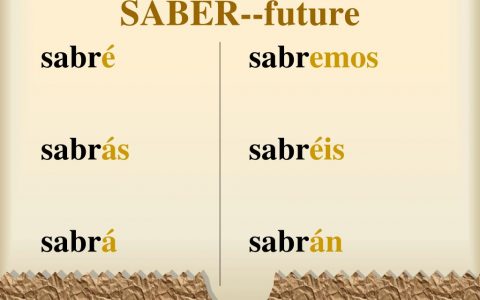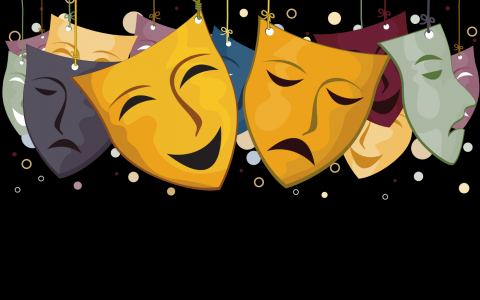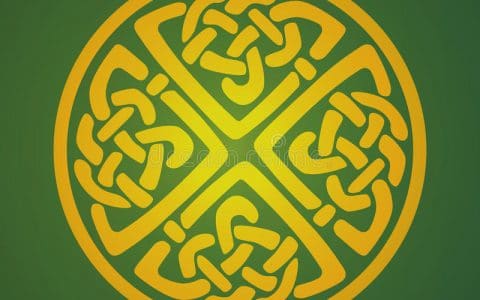The Celts would worship the Bull as Hu the Mighty. Moreover, he appears in their mythology with mystical value tied to the land’s and tribe’s fertility. Therefore, people treated the bull as a symbol for Esus, a god in Celtic mythology. Moreover, the animal itself was used in Druid sacrificial rituals.
Bulls are a notable animal in Celtic culture. Not only do they appear in several tales but also serve as a potent symbol. Besides, bulls were popular sacrifices to please the gods as well. Hence, if you would like to know more about this symbol, tune in to our article. Read on to know about the history, origin, and symbolism of the Celtic bull.
Celtic Bull Meaning
Carvings, clothes, tapestries, and jewelry normally included Celtic creatures. They have deep meanings as well as a variety of depictions. This is because the Celts believed in magic and animal-possessed energies.
The Celts thought that the Celtic animals had great abilities as signs, totems, or emblems. Hence, it is no surprise that they are able to charm people, Celts, and non-Celts alike. These symbols reflect courage, strength, patience, and other values that people aspire to have. Therefore, many still try to implement them into their daily lives.
People have long believed that adopting Celtic animal motifs will help them enhance their lives. Taking up the qualities of these animals is a lengthy tradition though. Additionally, people thought that this practice led to personal discovery, which would eventually lead to understanding.
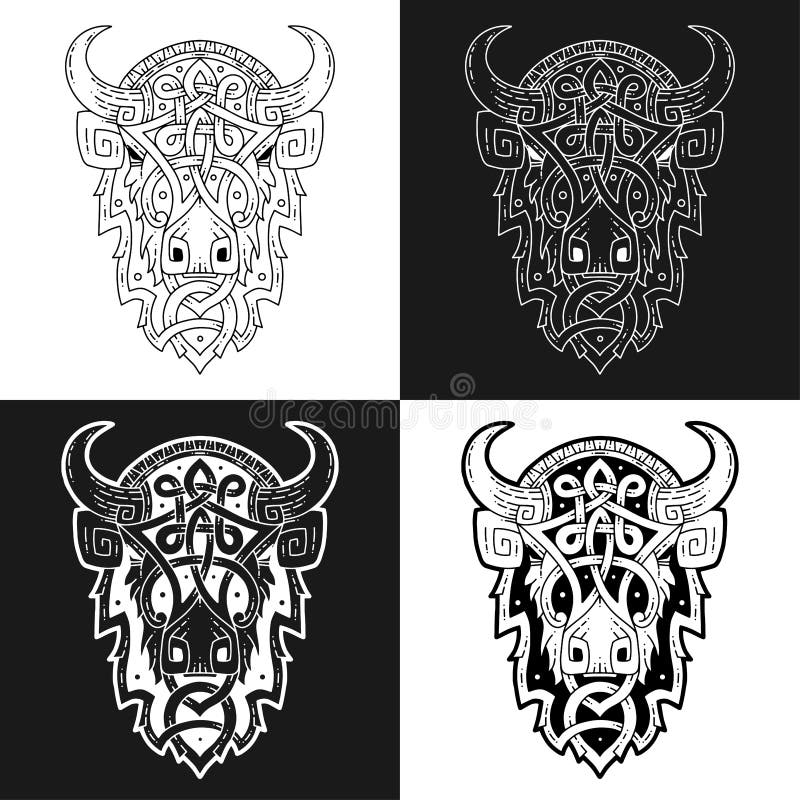
The bull is one of the most popular Celtic animals. This powerful beast signified the more male qualities of nature in Celtic mythology. The bull was a symbol of fertility for both men and women. Bulls were among the first tamed animals to assist humans with farm work. They are robust animals capable of enduring long stretches of vigorous physical activity. The bull’s fiery nature makes it an excellent role model. However, it can be a touch too fierce at times, entailing guidance and taming. A bull might also serve as a source of food, adding another aspect to the mix: a provider.
Read Also: Chi Rho- history, origin, adoption, usage, and FAQs
The ancient Celts adored the sacred bulls. In a number of cults, this animal was very important. However, among the Celts, the practice of idolizing animals had faded. Presently, they view these animals largely as images of divinities.
Celtic Bull Symbol
Celtic mythology has beasts with their own magical abilities. The Celts adored bulls, and as a result, they appear in various myths. The following are some of the animal’s symbolic meanings.

Power and Strength
For their strength, dominance, and fury, the Celts revered and admired bulls largely. Especially all across the early Iron Age, they were the most often depicted animals in figures and statuettes. Their horns are a symbol of their strength and aggression.
Prosperity and Wealth
Bulls were a sign of riches in ancient Irish culture. Moreover, the number of herds a ruler owned could affect his position. Cow thievery from neighboring kingdoms was a risky sport for young men who earned status via their cattle raiding feats. The story of Táin bó Cuailnge involved two unique bulls wanted by two lords. Therefore, it focuses on the significance of these creatures in Irish culture.
Cattle, mainly bulls, had ties with agricultural plenty among the Celts since they were largely herding people. Besides, the bull also had a linkage with Cernunnos, the Celtic god of nature and abundance. You could find bulls on bowls, buckets, cauldrons, and firedogs, as well as Gaulish coins, as a bringer of fortune.
Fertility and Healing
In multiple cults, the bull appears to play a sacred role, besides having an association with fertility and renewal. Moreover, bulls were really popular sacrifices to fulfill vows. Particularly in the curative shrines Fontes Sequanae (also known as the Sequana Springs), Tremblois, and Forêt d’Halatte.
Sacrifice
In ancient times, bull sacrifice was popular in Celtic sanctuaries and burials. The Celts would offer bulls to the gods as both uneaten offerings and as part of the ritual feast. The sacrifice of a white bull was even necessary for some divination ceremonies.
In addition, the Celts assumed that the bull had relations with the Continental Celtic god Esus. Some say he appeared as a woodsman felling trees while ringed by bulls. On the other hand, some experts believe the tree and the bull are symbolic of sacrifice.
Celtic Bull History
Bulls were present in European visuals before the Celtic period in Britain, dating back to the Neolithic and Bronze Ages. Thus, this implied that they played a major role in prehistoric rites.
Protomes, furniture, and needleworks in bull-head forms have existed throughout history in various cultures. The Sumerians were the source of inspiration for the Persians, who in turn inspired the Greeks. The Greeks then handed it over to the Romans. The Celts, on the other hand, learned about it through trade with the East.

The ancient Celts evoked the spirits of numerous animals to provide them with the wisdom and traits they sought. Unfortunately, in ancient times, cattle were often popular sacrifices. The bull’s life-sustaining energy could confer fertility on the ground. As a result, the sacrifices of the bulls took place. When Druids begged God for blessings, they sacrificed white bulls as part of a rite.
The Celts considered the bull as a symbolic protector for a family or a community in distress. They believed it could increase their riches and fertilize their lands since it mirrored the sun’s energy.
Celtic Bull Mythology
You can spot the depiction of bulls in paintings, statues, and sculptures across Celtic mythology. People believed bulls to have ties with certain Celtic deities. Thus, they regarded a bull to be a robust, strong animal that could benefit humanity and improve divine powers.
Celtic Bull and Tarvos Trigaranus
Tarvos Trigaranus is the Latin name for a likely Celtic deity. Likewise, he is a Bull God whose name literally means ‘bull with three cranes’. The Latin phrase was originally a title carved into a 1st-century stone sculpture. Nonetheless, scholars believe it was also the name of a Bull God. He is represented as a bull, backed by cranes or other three long-legged marsh birds, as the name implies.
You will find two stone sculptures of Tarvos Trigaranus in Paris and Trier, Germany. He finds a place alongside the Celtic gods Esus, Cernunnos, and Smertrius in a Paris sculpture. The unearthing of this sculpture took place in 1711, beneath Notre Dame Cathedral.
Around the year 26 CE, a group of boatmen who cruised the Seine River built the Jupiter monument in Paris. The tale behind the sculpture has unfortunately been lost to time, but researchers have linked it to a Celtic myth.
The bull had a historic association with the Celtic god Esus. Well, Esus is a woodsman chopping down a tree. You can spot him sheltering a bull and three birds in another scene of the same artwork. Scholars are not sure what the scene refers to, but they think it has something to do with rebirth mythology. Although a hunter killed a bull in the story, the cranes brought him back to life.
Celtic Bull and The Cooley Cattle Raid
Totemic beasts’ epic power often links to the forces of nature and the universe. There were two giant bulls – Donn Cailnge, the brown bull of Ulster, Cooley, and Finnbennach, the white bull of Connacht. However, earlier they were herdsmen with the names Friuch and Rucht, respectively. You will find their mention in the Ulster Cycle of Irish mythology.
The tale titled Táin bó Cuailnge, tells of a supernatural rivalry between two men, Friuch and Rucht for Ireland. Nonetheless, they continued fighting even after they evolved into animals with human reasoning and linguistic abilities. Furthermore, their battle lasted countless lifetimes as they morphed into ravens, stags, water animals, and even herd keepers. Needless to say, they formed a deadly battle alliance.
Finally, Friuch morphed into Donn Cailnge, a brown bull, while Rucht transformed into Finnbennach, a white bull. A spell managed to split the two bulls, the brown bull in Ulster and the white bull in Connacht.
However, when their paths crossed again one day, they fought through the days and nights. Donn Cailnge eventually killed Finnbennach, but the brown bull suffered from severe injuries. Henceforth, he, too, died in the end. However, with Donn razing the White Bull, the Irish political landscape is set.
Celtic Bull and The Medb-Ailill Battle
Other figures in the story are also responsible for the meeting of the two bulls. It stems from Queen Medb of Connacht’s long-standing feud with King Conchobar of Ulster. The story begins, however, with a domestic feud between Queen Medb and her consort Ailill. The cause of the dispute was over who held the most precious assets.
Ailill had a lovely white bull, and Medb longed for Cooley’s equally superb brown bull. As per some stories, the queen waged war on Ulster in order to forcibly obtain the brown bull. The brown bull was the queen’s trophy after she won the war. She carried it back to Connacht, where the two bulls reunited.
These cases illustrate that besides being a major figure in Celtic mythology, the bull had a role in the legends.
Celtic Bull Literature
The Book of Leinster, the Yellow Book of Lecan, and the Book of the Dun Cow are three popular manuscripts. These three books seemingly consist of the bulk of Irish Celtic mythology. Additionally, they contain somewhat different versions of the same stories (particularly the Táin bó Cuailnge or Cooley Cattle Raid).

The Book of the Dun Cow is the earliest of three prose volumes, dating from circa 1000 CE. The mythology apparently housed within it is far older and has been passed down through generations by oral tradition. Some even claim that the book was crafted from 500-year-old cow skin.
Celtic Bull Local Culture
The Celts regarded the bull as a symbolic emblem. Besides, they used it as a name for towns, like Tarbes in southern Gaul (also famous as the bull town). You can also find bull symbolism on coins and statuettes, namely in Gaul, Scotland, and England.
Some Celtic tribal names, like the Taurisci or Bull People, included animal references. It was typical for a clan to exhibit the head or pelt of their clan animal. Besides, they would also paint or tattoo the animal’s sign on their shields and bodies.
Celtic Bull Religion and Sacrifices
There is plenty of evidence on bull sacrifice, as per historians. Though these bulls were mostly eaten, distinguishing between a feast and a sacrifice can be difficult at times.
Classical sources talk of animal sacrifices in various rites. Pliny the Elder reports the killing of two white bulls on the occasion of mistletoe cutting. The Celts of Gaul, as per Julius Caesar, burnt animals trapped with human captives alive every year.
At times, people think the bull has a connection with a deity. For example, the Continental Celtic god Deiotaros, whose name means ‘divine bull’ or ‘bull god’. Thus, this implies that he has a relation to Gaul’s Tarvos Trigaranus.
Celtic Bull Divination
The druids and bards performed Divination rites in the hopes of foreseeing the future. The majority of these rituals used animals to convey signs. The Tarbh Fess (bull feast or bull-sleep) was an ancient Irish rite of divination that used bulls.
A poet who received the training of a seer would eat raw meat during the ritual. Further, some stories state the slaughter and cooking of a bull. Therefore, the poet would eat both the flesh and the broth. Following, he would go to sleep, covered in the hide of the freshly slain bull. The druids would chant over him until they had a vision that unveiled the next rightful king’s identity.
The most elevated poet could punish any king who appeared unfit to reign. The poet’s vision could be cryptic at times. Chanting and trances, in addition to dream states, were famous in some divination practices.
A literary visitor from the Trotternish district recorded a similar bull sacrifice in 1769. The rite, described as ‘awful solemnity’, seemingly lasted for a long time. The Scottish Highlanders wrapped a guy in bull skins and left to dream of the future. Furthermore, in the hopes of receiving psychic insight, the diviner’s placement would be under a high waterfall.
Celtic Bull Art
The famous gilded silver bowl termed Gundestrup Cauldron, found in Denmark in 1891 CE, influences Celtic mythology. Its relief panels depict images of animals, sacrifice events, warriors, gods, and other motifs. Besides, it dates back to the 3rd and 1st centuries BCE. As per some historians, it is Celtic mythology’s Rosetta stone.
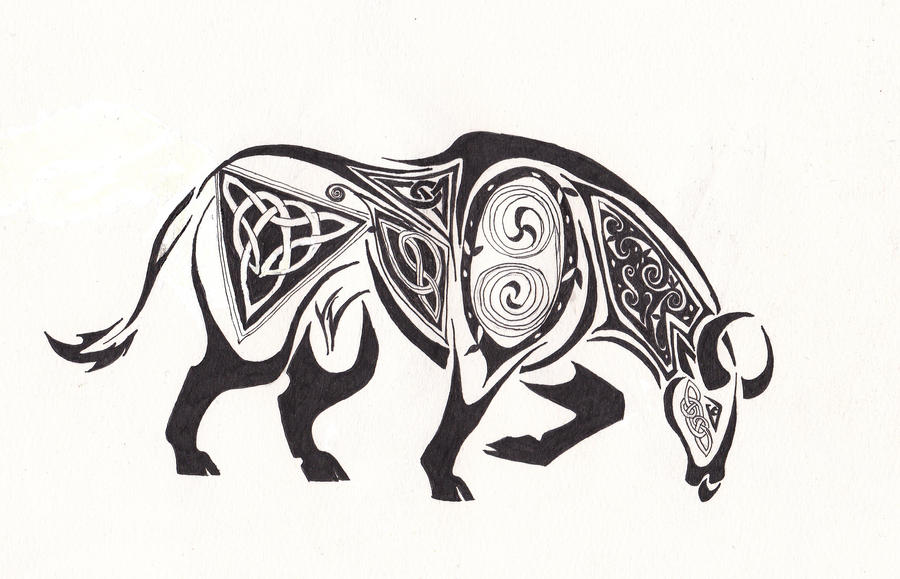
Artists back then deemed the bulls on the cauldron to be surreal beings. Further, they depicted the bulls as far larger than their human perps. There is a dead bull as well as a scene with three warriors going to slaughter three bulls. Thus, this hinted at hunts or ritual sacrifice in Celtic culture.
Celtic Bull Modern Day
In modern-day France, Ireland, Scotland, and Wales, bull symbols are still popular in religious iconography and cultural icons. The Cattle Raid of Cooley is still a popular legend in the area, with links to present rural living. The creature still has a strong meaning. Besides, you can often spot it in art, fashion, and tattoo designs.
Celtic Bull FAQs
Well, it is now time to answer all the queries that you might have about the Celtic Bull. Henceforth, take a look at all the most common questions on the web regarding the same.
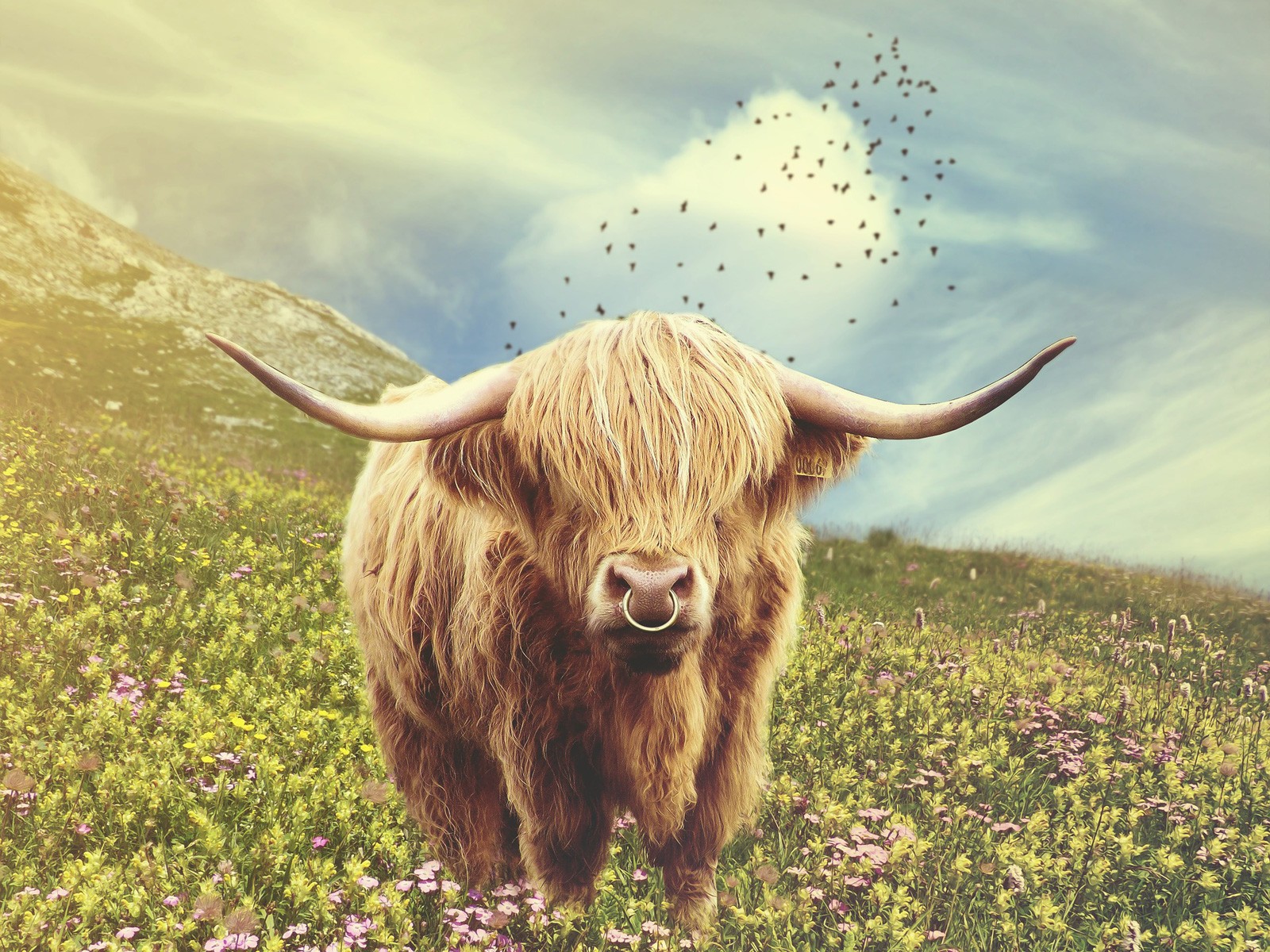
What is the Celtic Bull?
The Celtic bull is a sacred animal that reflects a strong will and stubborn character traits. Hence, the name ‘bull-headed’ came into existence.
Additionally, you will also find the bull on ancient Celtic coinage. Moreover, this also served to link the Celtic bull symbol to luck and prosperity.
What does the Celtic Bull symbolize?
The Celtic bull is a male sign of vigor and a female symbol of fertility. Besides, you’ll notice bull images on robes, bed sheets, pillows, and other items as emblems of sexual strength and endurance. Additionally, this sign also represents the traits of a bull, such as extremism, strong will, and toughness.
The Celtic people revered the bulls since they signified virility, strength, and endurance. As they are such active creatures, there was also a link between the Celtic bull and productivity. Since these animals provided food for the Celtic people, the Celtic bull became a symbol of abundance.
Discuss the significance of the bull in Celtic culture.
In Celtic symbolism, the bull is a prominent figure. Ritual deposits, artistic portrayals, place names, and tribal names indicate the value of this beast. In addition, the Celts prized bulls for their vitality and physical endurance. Moreover, all across the Celtic realm, people viewed the bull as a symbol of solar energy.
Besides, fertility, riches, rank, ancestry, and kin are all linked with the bull. During prophetic rites, Druids sacrificed white bulls or harvested mistletoe, which they used to make a cure for infertility.
The number of a Celtic clan’s herds, particularly the bulls’ strength, was a means to assess them. The Celts regarded the bulls as a symbol of wealth.
The bull was also one of the Celtic zodiac signs. Gender plays an important role in this zodiac, which is an interesting fact.
The cow (female) has a firm tie to the Moon and represents the Sacred Feminine. On the other hand, the bull has a relation with the Masculine and Solar-focused.
What do cows signify in the Celtic culture?
In Celtic culture, the cow represents Brigit, the goddess of earth, birth, health, and care. A cow’s spiritual value, like that of other cultures, implies abundance, fertility, potential, and, most importantly, the beginning of life.

